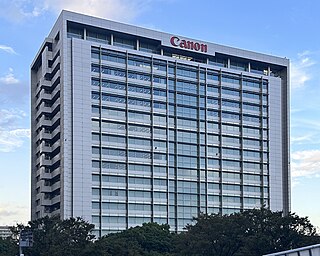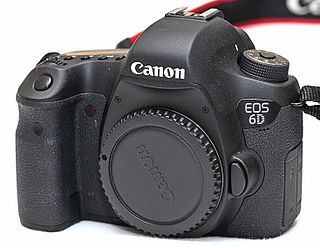
Canon Inc. is a Japanese multinational corporation headquartered in Ōta, Tokyo, specializing in optical, imaging, and industrial products, such as lenses, cameras, medical equipment, scanners, printers, and semiconductor manufacturing equipment.

The Digital IXUS is a series of digital cameras released by Canon. It is a line of ultracompact cameras, originally based on the design of Canon's IXUS/IXY/ELPH line of APS cameras.

Canon EOS is an autofocus single-lens reflex camera (SLR) and mirrorless camera series produced by Canon Inc. Introduced in 1987 with the Canon EOS 650, all EOS cameras used 35 mm film until October 1996 when the EOS IX was released using the new and short-lived APS film. In 2000, the D30 was announced, as the first digital SLR designed and produced entirely by Canon. Since 2005, all newly announced EOS cameras have used digital image sensors rather than film. The EOS line is still in production as Canon's current digital SLR (DSLR) range, and, with the 2012 introduction of the Canon EOS M, Canon's mirrorless interchangeable-lens camera (MILC) system. In 2018 the system was further extended with the introduction of the EOS R camera, Canon's first full frame mirrorless interchangeable lens system.

A digital single-lens reflex camera is a digital camera that combines the optics and mechanisms of a single-lens reflex camera with a solid-state image sensor and digitally records the images from the sensor.

The Canon PowerShot G is a series of digital cameras introduced by Canon in its PowerShot line in 2000. The G series cameras are Canon's flagship compact models aimed at photography enthusiasts desiring more flexibility than a typical point-and-shoot without the bulk of a digital single-lens reflex camera.

The Canon EOS 5D is a 12.7 megapixel digital single-lens reflex (DSLR) camera body produced by Canon. The EOS 5D was announced by Canon on 22 August 2005, and at the time was priced above the EOS 20D but below the EOS-1D Mark II and EOS-1Ds Mark II in Canon's EOS digital SLR series. The camera accepts EF lens mount lenses.
The Canon PowerShot S is a series of digital cameras released by Canon, as part of the wider PowerShot range. The S-series was originally a line of compact point-and-shoot cameras, slowly evolving into a prosumer line of cameras slotting right beneath the G-series cameras. The line later branched off into Canon's line of super-zoom cameras. The PowerShot ELPH line is a branch of the S-series, due to its model number designations in the United States, as well as the similarities between the PowerShot ELPH S100 and the PowerShot S10

Live preview is a feature that allows a digital camera's display screen to be used as a viewfinder. This provides a means of previewing framing and other exposure before taking the photograph. In most such cameras, the preview is generated by means of continuously and directly projecting the image formed by the lens onto the main image sensor. This in turn feeds the electronic screen with the live preview image. The electronic screen can be either a liquid crystal display (LCD) or an electronic viewfinder (EVF).

Digital Imaging Integrated Circuit is Canon Inc.'s name for a family of signal processing and control units for digital cameras and camcorders. DIGIC units are used as image processors by Canon in its own digital imaging products. Several generations of DIGICs exist, and are distinguished by a version number suffix.

The EOS-1Ds Mark III is a digital SLR camera body by Canon designed for professional photographers. The Canon EOS 1Ds Mark III is successor to the EOS-1Ds Mark II and was announced in August 2007. The camera features a full-frame 21.1 megapixel CMOS sensor with 14-bit analog/digital converters for a total colour depth of 16,384 tones per subpixel. It features a three-inch (76 mm) LCD screen, capable of "Live View," and dual DIGIC III processors allowing it to shoot at up to five frames per second.

The Canon EOS 5D Mark II is a 21.0 effective megapixel full-frame CMOS digital single-lens reflex camera made by Canon, the first Canon EOS camera to have video recording capabilities. It succeeds the EOS 5D and was announced on 17 September 2008.

The Canon EOS 7D is a high-end APS-C digital single-lens reflex camera made by Canon. It was announced on 1 September 2009 with a suggested retail price of US$1,699, and was marketed as a semi-professional DSLR camera.

Magic Lantern is a firmware add-on for various Canon digital single-lens reflex (DSLR) cameras and the EOS M. It adds features for DSLR filmmaking and still photography, and is free and open-source.

The EOS C300 is a digital cinema camera in the Cinema EOS range. It was announced by Canon on November 3, 2011.

The Canon EOS 5D Mark III is a professional-grade 22.3 megapixel full-frame digital single-lens reflex (DSLR) camera made by Canon.

The Canon EOS 6D is a 20.2-megapixel full-frame CMOS digital single-lens reflex camera made by Canon.

The Canon EOS 7D Mark II is a professional digital single-lens reflex camera made by Canon. It was announced on September 15, 2014 with a suggested retail price of US$1,799. It features a 20.2 effective megapixel APS-C CMOS sensor, Full HD video recording at 60 fps, 10.0 frames per second continuous shooting, a 100% accuracy viewfinder that offers 1× magnification. It also features a 65-point auto-focus system, a built-in Speedlite transmitter and a new 150k RGB pixels + IR metering sensor. It was preceded by the Canon EOS 7D.

The Canon EOS 5DS and EOS 5DS R are two closely related digital SLR cameras announced by Canon on February 6, 2015. Both are professional full-frame cameras with 50.3-megapixel sensors, the highest of any full-frame camera at the time of announcement. The only difference between the two models is that the sensor of the "R" version includes an optical filter that cancels out the effects of a standard optical low-pass filter. This distinction is roughly similar to that between Nikon's now-replaced D800 and D800E. Canon stated that both the 5DS and 5DS R will not replace the older EOS 5D Mark III; therefore, both the 5DS and 5DS R will have their new positions in Canon's DSLR camera lineup.

The Canon EOS 5D Mark IV is a professional-grade 30.4-megapixel full-frame digital single-lens reflex (DSLR) camera made by Canon.

















